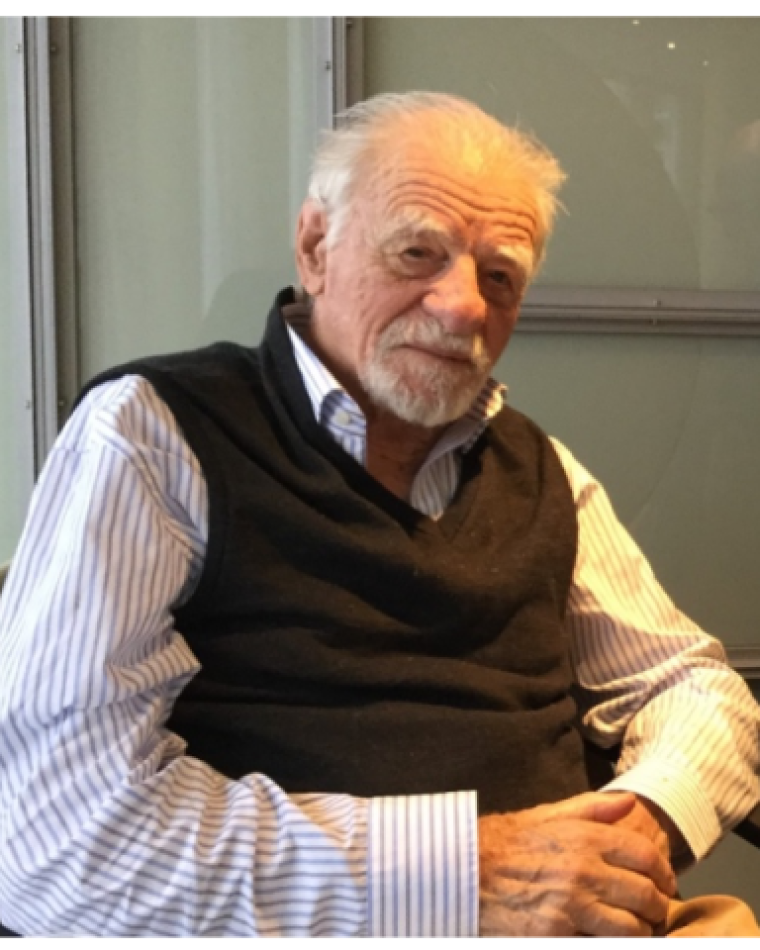
K. Alex Müller
K. Alex Müller
Contact Menu
On January 9, 2023 we lost our dear friend and estimated colleague K. Alex Müller, IBM Fellow and Professor of Physics at the University of Zurich, Nobel Prize Winner in Physics in 1987.
Alex was born on April 20, 1927 in Basel, Switzerland. He spent most of his childhood with his mother in the Italian speaking part of Switzerland (Ticino). After her early death he stayed in a boarding school in Schiers located in the Swiss mountains where he also received the Matura.
He studied physics at the ETH Zurich where Prof. Wolfgang Pauli played an essential and influential role throughout his scientific life. There he performed his PhD work under the supervision of Prof. Georg Busch. This work entitled “Paramagnetic Resonance of Fe3+ in SrTiO3 Single Crystals” was the beginning of a long scientific research career in the field of perovskites, ferroelectrics, static and dynamic Jahn-Teller effects, phase transitions, critical and multicritical phenomena. Since his doctoral thesis his main experimental tool was electron paramagnetic resonance (EPR) in order to investigate local electronic, magnetic, and structural properties of oxide systems. In the following years Alex concentrated on SrTiO3 and related compounds and published many breakthrough papers on this subject.
His professional career began at the Battelle Memorial Institute in Geneva, where he became the manager of the magnetic resonance group (1958-1963) and a Lecturer at the University of Zurich, receiving the title of Professor in 1970. In 1963, he joined the IBM Zurich Research Laboratory in Rüschlikon, as a research staff member and later became head of the Physics Department from 1971-1985. During this time he deepened his knowledge in the above mentioned topics and became world famous for his research in the field. At the age of only 53 he concluded that the until then achieved honours, he could have finished his scientific career and do administrative work only.
However, things went differently as we all know, mainly influenced by a two years sabbatical stay of Alex at the IBM TJW Research Center in Yorktown Heights, where he had his first encounter with the field of superconductivity. He decided to get deeply acquainted with this topic, being inspired by the discovery that granular Al has a higher superconducting transition temperature than the bulk form. Back to Zurich he even gave lectures on superconductivity at the University of Zurich.
During this time Alex made the interesting observation that superconductivity was very rarely observed in oxides and specifically in oxide perovskites. Yet, the few existing exceptions had unusually high transition temperatures in view of their low density of states at the Fermi level. This inspired him to think of a novel electron pairing mechanism beyond the BCS scheme admitting for unconventionally large electron-lattice interactions. Furthermore, he got involved in the Jahn-Teller polaron predicted by the work of his friend Prof. Harry Thomas and his group at the University of Basel.
At this moment he suggested to J. Georg Bednorz to search for oxide superconductors with Jahn-Teller ions. While the following few years were rather disappointing, they reached the breakthrough in 1986 with the discovery of high temperature superconductivity (HTSC) in ceramic cuprates. A year later both were awarded with the Nobel prize in physics. Furthermore, he received many distinguished awards and honours.
Alex spent the years after this huge achievement with more detailed research in HTSC, but also came back to his former routes, namely ferroelectricity and structural phase transitions in perovskite oxides.
As for HTSC it was important to him to demonstrate that his starting idea of the Jahn-Teller polaron was internationally acknowledged in spite of a strong scientific objection in the community. He founded the research project of isotope effects at the University of Zurich where pioneering results could be achieved supporting the idea of unconventional strong electron lattice interaction as source of the pairing glue.
Besides of being an ingenious researcher and scientist, Alex was also an excellent teacher and lecturer and enjoyed the university life intensively by attending seminars and supporting students. With Alex we lose a very good friend and a highly appreciated colleague, an excellent inspiring scientist, and a devoted teacher.
Annette Bussmann-Holder
Max-Planck Institute for Solid State Research, Stuttgart, Germany
Hugo Keller
Physics Institute, University of Zurich, Zurich, Switzerland
May 5, 2023
The Nobel Prize in Physics 1987
Born: 20 April 1927, Basel, Switzerland
Affiliation at the time of the award: IBM Zurich Research Laboratory, Rüschlikon, Switzerland
Prize motivation: "for their important break-through in the discovery of superconductivity in ceramic materials."
Prize share: 1/2
Work:
When certain metals are cooled to extremely low temperatures, they become superconductors, conducting electrical current entirely without resistance. However, very low temperatures, just a few degrees above absolute zero, are required for this phenomenon to occur. In 1986 Alex Müller and Georg Bednorz discovered that a material composed of copper oxide with lantanum and barium additives became superconducting at a significantly higher temperature than previously tested materials. This sparked extensive research into similar materials.
K. Alex Müller – Facts. NobelPrize.org. Nobel Media AB 2019. Thu. 24 Jan 2019. <https://www.nobelprize.org/prizes/physics/1987/muller/facts/>